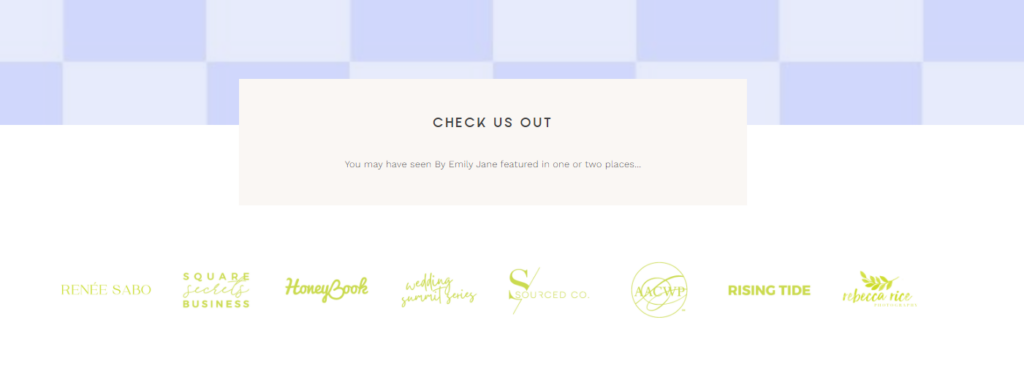If you want potential clients to invest their hard-earned cash in your services, you already know you’re going to have to talk yourself up on your website.
But here’s the thing: literally anyone can whip up a gorgeous website and claim to be the best at what they do.
So what you need is a little something to back up your claims—that way, potential clients will feel like they can trust the quality of your work.
In the marketing world, we call this “social proof.”
In other words, it’s evidence supplied by someone else that proves you’re as good as you say you are.
The term itself comes from a book called Influence by a psychology professor, Robert Cialdini (dare I say that it’s an incredibly influential book in the marketing world?). Basically, he says that humans love to observe what other people are doing and then use that information to validate our own choices.
It’s the idea behind showing you not just the star rating for a product, but the number of people who have rated it. If 5,290 Sephora shoppers have given a mascara an average of 4.9 stars, who are you to disagree with their wisdom? Once you start looking, you’ll notice social proof everywhere online—and not always used ethically, either. (In his book, Cialdini actually refers to ways of influencing others as weapons of influence, and you can see why).
But like I said above, we’re in an era when anyone can come online, sign up for a Squarespace account, and start getting Stripe notifications—whether or not they can deliver on their promise.
So you need to prove to potential clients that you are who you say you are, especially if you’re a service provider who requires a deposit to secure a spot. Social proof shows that a) you’re not going to ghost once that money hits your bank account, and b) you’re going to deliver the caliber of work that your client hired you for.
Here are 5 types of social proof that creative entrepreneurs should use on their website:
Testimonials from your (favorite) past clients
In my opinion, testimonials are the gold standard of social proof—a past client explaining, in their own words, why they chose to book you, what their experience was like, and how it made them feel.
Now for a few of my strongly-held opinions on testimonials (I have a lot):
- Don’t stash these on a separate page. Instead, carefully choose the best ones and add 1 or 2 per page of copy.
- Match the testimonial to the service. So if you have a separate page for your VIP design day, pull a testimonial from a client who’s done that exact service. (If you’re launching something new and don’t have a testimonial yet, then go for one that talks about your client experience, or you as a person.)
- Don’t put testimonials in carousels. This is a hill I will die on. Every time I see someone do this, they’ve stuck some of the best stuff at the end, where people might never see them.
Also: edit your testimonials. Judiciously. This is one of the most common mistakes I see when creatives and service providers DIY their own website copy—long testimonials with a lot of filler.
Just because a client wrote a 300-word review does not mean that you need to use every word. Pluck out the relevant sentences. Be ruthless (just make sure your edits don’t change the meaning of what they said). Chop things up into shorter paragraphs.
“As seen on” logo bars
If you’re a wedding photographer, maybe your work has been featured in industry-leading blogs like Style Me Pretty or print magazines like Brides.
Since you’re already putting in the work to get featured on industry-leading sites or blogs, double down and display those logos on your site in a logo bar.
There are plenty of variations here for people who don’t submit their work for features—another popular option is an “As heard on” bar featuring the logos of podcasts you’ve guested on or conferences where you’ve spoken.

I’ve also seen online service providers, like brand designers or copywriters, specify where their clients have been published, or where their work has appeared. (Just, you know, get permission from your clients first.)
One caveat: it’s 2023, and we all know by now that some publications are pay-for-play. I’m not going to name names, but you know who they are. As a result, they’re not impressing anyone. (Yes, your ideal client probably got the same cold DMs on Instagram that you did, and she’s underwhelmed.)
By the numbers
Especially if you’ve been in business for a while, this is a great way to brag about your experience without straight-up bragging.
My favorite way to have fun with this is to choose 2 or more “hard” numbers, then throw in a final number that’s a little more fun, like so:
| WE’VE DESIGNED 50+ LOGOS | FOR OVER 20+ INDUSTRIES | AND BOUGHT 457 FONTS ALONG THE WAY |
(I like to think of this as the McDonald’s trick. On every sign, below the word “McDonald’s,” there’s a little line that says “Billions and Billions Served.” They’ve been showing their numbers since 1955. If it worked for them…)
Awards
You probably don’t need me to tell you this, but:
If you’ve won an award for your work, put it on your website—as long as it’s relevant to the work you’re doing now.
Badges & memberships
Basically, we’re talking about a stamp of approval showing that you meet someone else’s standards, whether through formal training, membership in an organization, or by pledging to adhere to a certain set of values.
As an example: website designers who achieve Showit Design Partner status get a digital badge that they can (and definitely should) display on their site.
If you’ve received a certification that reflects your brand values, that can also serve as powerful social proof that affirms your commitment to those values. An elopement photographer who regularly works on public lands might choose to display a badge that proves that he adheres to Leave No Trace principles.
Bonus: choose the one that means the most to your ideal clients, and pop it in your email signature, too.
Want to learn more about copywriting and brand messaging?
I’ve got your back. Sign up for my newsletter to get the latest on copy tactics that work, spicy takes on bad marketing, and other ideas that will help you connect with your people.
And if you’re in need of vibrant, playful web copy so that you can reach your next wildly ambitious business goal, I do that too. Learn more about my website copywriting services and decide if we’re a match (fingers crossed).
